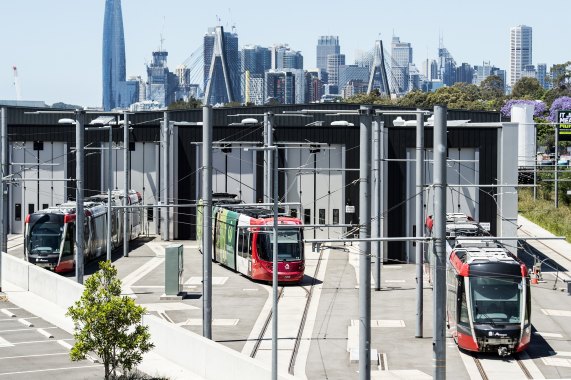This was published 2 years ago
Government ‘hopeful’ inner west light rail will return sooner than first feared
By Tom Rabe
Sydney’s faulty inner west light rail could return far sooner than first feared, according to a senior transport official, but Premier Dominic Perrottet has acknowledged the service’s suspension could hinder the return of workers to the CBD as the government attempts to revive the city.
Transport for NSW chief operations officer Howard Collins said he was confident the light rail would not be out of action for 18 months, with the government now looking at an alternative facility to repair the 12 cracked trams faster.

Trams used in Sydney’s inner west light rail on Saturday.Credit: Steven Siewert
“I’m hoping that it will be a lot less than 18 months, I’m pretty confident,” Mr Collins said.
He added the system could resume in a reduced capacity between Lilyfield and Central Station once a handful of trams were repaired.
“If we get four to six vehicles back, we’ll start to shuttle Lilyfield to Central, but we’re not sure when that will be yet.”
The Herald revealed last month that cracks had been discovered on several trams, which forced the suspension of the service. Cracks were subsequently found on every tram, prompting the government to cancel the service for more than a year.
The massive outage comes as the government works to entice workers back into Sydney’s suffering CBD after the months-long Delta-lockdown.
Mr Perrottet on Sunday described the system-wide cancellation as “terrible” and said the government would provide ongoing bus services to the commuters impacted by the outage.
“It’s not helpful, clearly, and it’s something that we will work through,” he said. “We do need people to come back to the Sydney CBD. I want a thriving city.
“Obviously it’s unacceptable. But what I can do as premier what my team can do is ensure that there are public transport options available to minimise any disruption.”
About 10,000 daily trips were taken on the service in mid-October, compared to 30,000 pre-COVID. About 5000 daily trips were taken on the replacement bus services last week, Mr Collins said.
Cracks in the Spanish-built tram fleet have occurred across the world, with the West Midlands public transport network dealing with a similar problem in the United Kingdom.
Transport for NSW is now exploring whether it can find other facilities where a production line can be set up to repair the trams in a more efficient way.
The government also considered whether it could split the CBD light rail trams in half to be able to run on the inner west line, but decided it was too complicated to make the necessary changes, given the different wheelbase of the two vehicles.
The floors of the trams needed to be stripped back to reveal the true extent of the cracking on the inner west trams. Mr Collins said once they were identified, the cracks could be seen moving once the tram was in operation.
“The vehicle has been out on tests and the cracks have been seen to move. The vehicles weren’t unsafe at the time of operation, but the advice I’ve been given is if we’d left them as they are, the cracks would have propagated further,” Mr Collins said.
“It looks like it wouldn’t have failed in a way that would have injured anybody, but it likely would have got lower and lower until the body scraped on the ground.”
Transport Minister Rob Stokes last Friday said the serious flaws found in the inner west trams were likely to be “far broader in scope” than those in Sydney because thousands of the same tram types operated around the world, including Europe and the US, as well as in Newcastle and Canberra.
The inner west trams were made by Spanish manufacturer CAF, whereas those used on the $3.1 billion eastern suburbs light rail line were built by French company Alstom.
Opposition transport spokeswoman Jo Haylen said the light rail’s closure would likely deter inner west residents from returning to the CBD.
“The inner west light rail line’s closure has become an economic handbrake on the post-COVID recovery across the inner west, Pyrmont, and Chinatown,” she said.
“It’s now harder for workers to get to work, students to get to school, and for patrons to get to restaurants, bars and retail businesses all desperately in need of customers.”